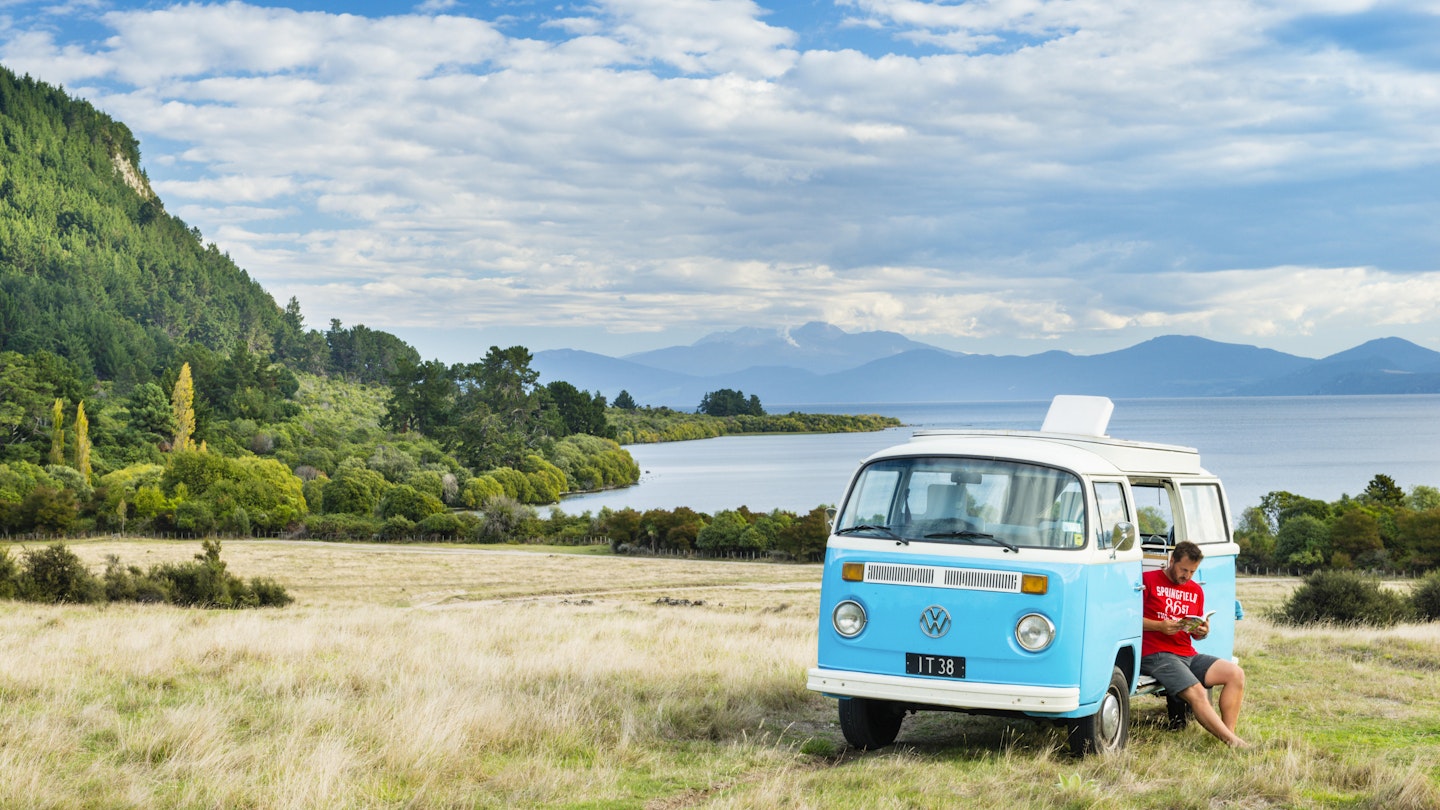Travel Options in New Zealand
Floating at the western end of the Pacific, New Zealand is long, narrow, relatively sparsely populated, and split in two by the Cook Strait. Seeing the whole of New Zealand will involve crossing this waterway; however, regular car ferries make it easy to road trip right around North Island and South Island in a rented car or campervan.
Most people arrive in either Auckland, Christchurch, or Wellington – all well served by public transport – but once you leave the big cities, vast expanses of rolling countryside, tall mountains, and areas of almost impenetrable native bush await exploration.
In many parts of the country, it can be a long way to the next town, and most New Zealanders tend to travel by car. Many visitors share this mode of transport, although public transport does connect the main hubs, running less frequently to outlying towns, villages, and tourist sites.
See More of New Zealand by Driving Around the Country
New Zealand’s stunning scenery makes for remarkable road trips, and traveling by car is both convenient and flexible, especially when visiting attractions away from main arterial routes. Many of the best-known national parks are remote, meaning you’ll need a vehicle to properly explore them; however, visiting many areas is also possible through organized tours or hiking.
Driving around New Zealand is straightforward, with light traffic outside of the major cities. Additionally, visitors should not worry about wildlife on the roads as much as in other countries. Driving is on the left-hand side, and visitors are usually allowed to use their home driver’s license for up to a year.
Keep in mind that car rentals aren’t always cheap, and insurance costs can be high for drivers under 25. If you’re traveling between the islands, confirm whether your rental vehicle is allowed on the Interislander or Bluebridge ferries across the Cook Strait. It is recommended to arrange your vehicle’s ferry passage in advance to guarantee a spot.

When driving in remote areas, long stretches between gas stations can occur, so be sure to fill up before embarking on long trips. Additionally, some roads may be gravel or dirt, especially in rural regions, featuring windy and narrow stretches, along with tight squeezes over mountain passes. One-way bridges are common, particularly on the South Island; look for signs indicating who gives way to oncoming vehicles.
Distances in New Zealand can be deceptive as road travel is often slow. Getting caught behind a campervan or truck on a single-lane road can significantly increase your journey time. Weather events can also lead to road repairs and landslides, so checking road conditions before you hit the road is advisable.
Travel by Campervan for Ultimate Flexibility
Traveling by campervan or motorhome allows savings on accommodation costs, with campsites located in some of the country’s most scenic locations, including national parks. Numerous companies specialize in campervan rentals for travelers, including major operators and smaller agencies.
If you intend to freedom camp – staying overnight in designated free parking areas – your vehicle must be certified as self-contained. This requires the ability to carry your own water and dispose of your own waste. It’s important to understand that freedom camping does not mean you can park and sleep anywhere.
The rules have changed recently, and bylaws are set by local councils; thus, research is crucial. Visit local resources for camping advice and guidelines.
Bus Services Connect New Zealand’s Cities and Towns
Coaches provide good links between most large cities and towns in New Zealand. These can be booked in advance and are relatively affordable; however, local buses may be infrequent on rural routes and national parks.
Aside from regional bus services, InterCity is the national bus company, offering onboard WiFi and sometimes toilets. InterCity also provides flexible bus passes and discounts during the off-season.
Moreover, there are hop-on, hop-off buses and shuttles for tourists and backpackers, but these tend to be more expensive, and the lively atmosphere may not appeal to everyone.

Scenic Train Trips Let You Enjoy the Landscape as You Travel
While trains in New Zealand primarily focus on freight and city commuting, several scenic regional trains for tourists are worth considering for the stunning views along the way.
Great Journeys New Zealand operates three scenic routes with convenient stops. The Northern Explorer runs from Auckland to Wellington, the Coastal Pacific connects Picton to Christchurch, and the TranzAlpine travels from Christchurch to Greymouth through Arthur’s Pass.
Domestic Flights Are the Quickest Way to Travel Between Cities
While many visitors prefer overland travel in New Zealand, flying offers a quicker way to traverse the country while being mindful of environmental impact. Popular options include flights between North Island and South Island, and some camper rental companies provide one-way rentals, allowing flexibility in travel.
Air New Zealand serves as the national airline, connecting numerous destinations, while smaller local airlines service remote locations. It is essential to keep in mind that domestic flights can be delayed or canceled due to New Zealand’s unpredictable weather patterns.
Accessible Transportation in New Zealand
New Zealand’s attractions and national parks are generally accessible, featuring ramps and suitable paths for mobility-impaired individuals. Most public transport, including buses and trains, accommodates everyone through ramps and low steps.
The New Zealand Transport Authority (NZTA) offers resources for finding discounted accessible transportation, covering public transport and taxis. Many car rental services also provide accessible vehicles, while specialized rentals are available through dedicated companies.
Transport Passes for Major Cities
If you plan to experience public transport in New Zealand’s major cities, consider acquiring a prepaid transport card. These cards provide discounted fares and a capped daily maximum charge, making travel across various transport services convenient.
Some examples of helpful transport cards include Auckland’s AT HOP card, Wellington’s Snapper card, and Christchurch’s Metrocard. In the Otago region, including Queenstown and Dunedin, you can utilize the Bee card across the area.





